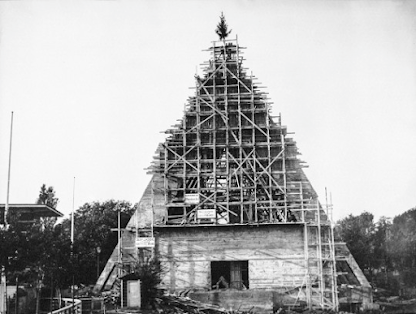We finally found it! After nearly ten days in Norway, we found a piece of trash! On the ground!
When one finds such an unusual - nay unheard of - object (such as The Loch Ness Monster, Arthur's Sword, Aaron's staff, a functioning Fiat) documentation is necessary.
My apologies for not using the metric system in that picture; it's the standard in Norway, which only became a country in 1905. Before then, it was part of Denmark-Norway, no, make that Denmark/Sweden/Norway, before then the Kalmar Union, OK, and the Holdenberg Dynasty years, and when the Treaty of Kiel gave Norway to Sweden (again)... As I mentioned, in 1905 it became an independent nation, and being sick and tired of all the previous entanglements (though a founding member of NATO), it has voted repeatedly against being part of the European Union. Because of that, you can't pay for things in Euros. Instead, the national currency covers everything:
Norwegians are tough. Only three percent of their territory can be farmed. On the other hand, if you're good at geometry, you'll realize that because of the lack of flatness in Norwegian topography,
it may be actually up to four percent if you count the tilted surface area.
However, as is typical in much of the world, the water in Norway is level. The Norwegians have taken advantage of this, and they are a largely-maritime people. The ocean invades much of the country in the form of fjords (don't hurt yourself, it's pronounced like "fyords), the longest of which is Sognefjorden, (as I said, don't hurt yourself) at 175 miles in length, winding its way into the heart of the long, skinny country.
The fjords snake all over the place.
While only the 61st country size-wise in the world, Norway is No. 2 for coastline, coming in right after Canada. I mean, you can't swing a smoked salmon-covered bagel without hitting a piece of coastline.
Remember the Vikings?
Oops! Wrong Vikings! Well, you know what I mean, the guys with horns on their helmets. Actually, the real Vikings never did that. The only metal helmet ever recovered from that era (found in 1943 on the Gjermundbu farm, and don't even try to pronounce it) lacked horns. Those apparently didn't come into vogue until the costume guy in a Wagner opera got the bright idea in the 1870's. So now you can tell the seven year old at your door on Halloween that he's historically inaccurate. Spoil sport.
The real ones figured out that other folks had more farmland than they did and so they started branching out a bit, sharing the prosperity. You know, "What's yours is mine and what's mine is mine." That actually was just a phase, around the 9th to the 11th centuries, and while pillage was involved in some parts, there was also a whole lot of legitimate exploring, colonization and influencing cultures as far flung as present Russia. See "Greenland," "Iceland," "Faroe Islands," "Ireland," "Vinland" (now commonly referred to as "North America,") and others.
As anyone who has seen the final conflict scene in Mission Impossible: Fallout is aware, the scenery is nothing short of spectacular. 'Breathtaking' comes close, but it and photographs don't convey how crazy big and open the place feels. I won't tell you how the fight scene ends here on Pulpit Rock and ruin it for you except that Tom Cruise doesn't die. Duh.
We couldn't find anything ugly in the whole country, except when Paula, giggling, told me to look in the mirror. Nice.
Beginning in the late 1930's, the G.H.Bass shoe company's "Weejuns" became popular here in the States. These "penny loafers" peaked somewhere in the 1970's, and I remember finally getting a pair as a teenager. I think I've had some ever since.
However, the real story goes back to Norway. Nils Tveranger apparently spent some time in the US and was intrigued by Iriquois moccasins. He combined these with some traditional Norwegian footwear features and started manufacturing his shoes in Aurland, Norway in the early 1900's. Some of these made their way back to the US and, you guessed it, were copied by the Bass shoe company and called Weejuns. Get it? Norwegian? Weejun? Call me if that's unclear.
You can still drop by the Aurland Shoe Company and even stroll around the small factory, where friendly folks are still turning out handmade loafers. Really, really nice handmade loafers. And not with pennies, no, no. They include a 10 kronner coin in the slot.
In a country sliced up vertically by the Ice Age and the resultant fjords, transportation was iffy for the first fifteen thousand years after most of the ice melted and people started moving in. Farms are small and isolated and were accessed by boats and horses: the low population density didn't warrant much else. Some early railway attempts for logging came and went, and only took hold in the less-rugged parts of the country by the mid- to late-1800's. Ferries were, and still are, common for navigating the fjords.
And by the way, tipped off by a nice lady we met at church in Oslo, we learned that several of the ferries offer - get this - hot dogs with big cheese-infested sausages wrapped in bacon. You just gotta love a country that offers suicide on a bun while crossing a gorgeous piece of water.
However, for more than a century, Norwegian experts have built the largest, longest, deepest and most complex underground projects in the world to get around the problem. They have the deepest subsea tunnel, in which your ears pop descending more than 1,000 feet under water, and the longest roadway tunnel, at 15.2 miles, the Laerdalsoyri to Aurlandsvangen tunnel (don't tick off any Norwegians by trying to say that, OK?), but which tunnel frankly lacks much of a view.
These guys are serious about tunneling. If you qualify, you can become a member of The (very real) Norwegian Tunneling Society, but I understand that the entry bar is quite high. Apparently, you have to prove (Family Search?) that somewhere in your genealogy there is the suggestion of a relation to a Norwegian mountain troll.
I don't know; chalk it up to long winters when the engineers were bored and doodling by their wood stoves, but plans have been solidified and specifications sent to bidders to build the first ship tunnel of any size under a mountain range to connect two waterways. Great Uncle Hjalmar would be proud.
Several cruise lines are concerned that the water slide and bungee-jumping towers may not fit. Oh, darn.
Norway leads the world in energy self-sufficiency. 98% of its electricity comes from hydroelectric power, and the remainder from wind. It has the highest percentage of electric vehicles in the world. Eighty percent of new vehicles purchased there are electric, and twenty percent of all vehicles on the road are electric, including the Bimmer we rented.
And you don't really have to speak Norwegian to guess what that writing means on our dirty bumper.
Anyway, nice car, but it took at least a half day for four sixty-somethings (Paula, me, my brother Mark and his wife Amy) even with our tech-savvy daughter Ashley around, to figure out the charging puzzle.
We started a race to figure out who could get the most working iPhone apps linked to different charging stations, and of course Ashley won, being some twenty-five years younger than the rest of the party. We got the hang of it after a few days, and started feeling very twenty-first-century-ish.
As mentioned above, Norwegians are a tough people. When the famous Norwegian explorer Roald Amundsen learned that Robert Peary had reached the North Pole first, he said, "Ikke noe problem. Gi meg et kart," roughly translated as "Dadgum it. No problem. Let me see the map," and headed south. In a boat designed and built to withstand being caught long-term in polar ice and with his co-explorer Fridjtoff Nansen (below, and a guy I would not want to get in a fight with on an ice floe)
they set off for the South Pole and bagged it on dogsleds. The account of their assault on the Pole speaks of their courage, preparation and sheer Norwegian toughness.
Their vessel, the Fram, which in Norwegian means "Fram," was kept afloat afterward, and in 1933 was dragged ashore by tough Norwegian guys in Oslo, and the museum built around it.
Now you can tour the very boat that Amundsen and his company used, and it is very impressive in its construction and their quarters and storage. There is a piano, sewing machines for sails and clothing, a metal forge for repairs, every crew member had their own cabin, they ate together in a sort-of large mess, etc. Very, very impressive. However, I'm still OK living in Raleigh. Where we have some really scary thunderstorms every once in a while. Oh, yeah, and it froze twice last winter. Just awful.
All told, Norway is a fascinating, gorgeous country, understandably proud of its accomplishments.














































